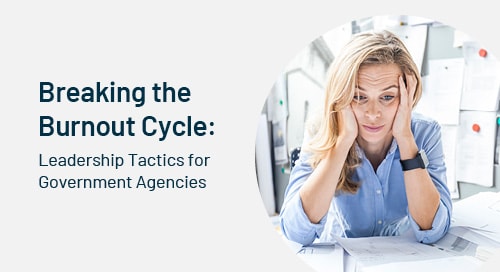 Low morale and burnout are pervasive problems in the private sector. But they are at critical levels in government agencies.
Low morale and burnout are pervasive problems in the private sector. But they are at critical levels in government agencies.
Consider these two facts:
· Government workers are less engaged and less motivated than workers in the private sector.
· Government workers are more likely to feel burned out than workers in the private sector (65% vs. 44%).
Let’s briefly consider the causes for this and how they can be remedied.
Snapshot: Causes of Lack of Motivation
To be fair, many government workers are motivated and engaged. They take their work seriously and are dedicated to serving the public. But the facts also show that many are less motivated than their peers.
“Bureaucratic red tape and limited opportunities for career growth demotivate many employees,” observed Bob Freytag, senior consulting partner at Blanchard. “Change in leadership is another factor. One politician gets voted out and another one gets voted in. This often results in a change of direction and priorities, and these rapid course corrections can sap motivation.”
Pay disparities between government and private sectors and a dearth of financial rewards tied to performance also play a role. A committed employee under financial duress can only struggle for so long.
Three Ways to Spur Motivation
Leaders have a diverse and powerful toolkit at their disposal. Here are three simple tactics to spur motivation:
1. Build and maintain trust. Leaders can build trust by being transparent and reliable and showing genuine concern for others. Trust promotes honest communication and collaboration, which results in improved performance.
2. Develop strong communication skills. A leader’s language should be honest, clear, and consistent. Encouraging regular feedback and actively listening to team members fosters trust and ensures alignment on goals and priorities.
3. Praise often. Publicly praising people is another powerful way to ignite motivation. It takes five praises to counteract one criticism, so leaders should be generous with their compliments. Additionally, there is a recognition gap between leaders and their people—direct reports feel underappreciated. This again shows that people crave praise and recognition.
Leadership Responses to Burnout
“It's important to remember that government workers are people first and workers second. Leaders should ask their people how they are really feeling, listen until someone’s finished talking, and try to help,” says Dr. Vicki Halsey, who is Blanchard’s vice president of applied learning, senior leadership consulting partner, and practice lead for SLII®.
One respite for the burnout epidemic is regular one-on-one meetings between leaders and their team members. These meetings give employees a chance to share their challenges and concerns. If there is a strong bond of trust between the leader and the direct report, one-on-ones become safe places for frank conversations. Leaders can use what they learn to address signs of burnout in the individual.
Unfortunately, burnout is not usually limited to one person. It often is a widespread phenomenon. Leaders should examine the workplace to determine if systemic issues could be the cause. The best leaders will identify and address root causes and chronic concerns.
Causes of Burnout
Employee burnout is an urgent issue for state and local agencies. Key causes of government employee burnout include:
· Unsustainable workload
· Little feedback from leaders
· Poor work/life balance
· Unclear communication in the workplace
Record employee attrition and chronic understaffing aggravate these issues. The result is that government workers experience significant stress—so much so that it erodes job performance (71%), willingness to go above and beyond (57%), attendance (41%), and relationships with colleagues (33%).
“People often focus on burnout as an individual issue rather than a social or communal organizational issue,” explains Christina Maslach in a recent interview for Blanchard’s LeaderChat podcast. Maslach is a psychology professor emerita at the University of California, Berkeley and coauthor of the book The Burnout Challenge.
Maslach shares that when you frame questions in terms of only the individual and their situation, you're not asking about what’s in the job environment that may be creating chronic stressors.
“There’s been a tendency to focus on helping the individual cope, which is fine, but that leaves out the other part of how we prevent—or lessen the risk—of burnout occurring. That takes a broader focus beyond the individual.”
Building a Better Future
Building morale and addressing burnout in government agencies ultimately lies with skilled leaders who know how to prevent burnout and help people find meaning in their work.
A leader’s power should not be underestimated. A leader has as much influence on a direct report as their doctor, therapist, or spouse. An empathetic leader can go a long way in turning a negative situation into a positive one. They can also create lasting goodwill, loyalty, and engagement. This is not an exaggeration—the results of empathetic leadership are quite stunning.
“A skilled leader can help motivate an employee and unleash their brilliance,” says Dr. Halsey. “That’s why leaders need to understand how much they influence others and how to bring out the best in their people.”
______________________________________________________________________
Interested in learning more about building morale and addressing burnout in government agencies? Check out these additional resources. They’re free, courtesy of Blanchard.
· Revitalizing the Government Workforce: Leadership Strategies to Retain Talent and Boost Engagement. A complimentary webinar featuring Blanchard leadership experts Bob Freytag and Vicki Halsey.
· The Talent Retention Playbook: Leadership Strategies for Government Agencies. A new Blanchard eBook with additional information for leaders on bringing out the best in people.
About the Author
More Content by Doug Glener
























